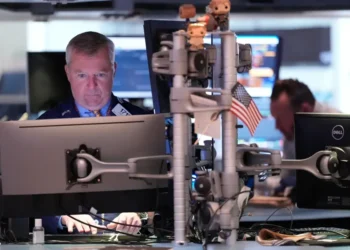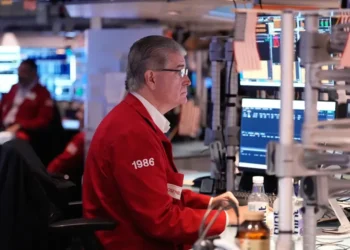Nvidia’s Third-Quarter Results Reinforce Investor Confidence as AI Spending Remains Elevated
The demand for generative artificial intelligence continues to reshape global markets, and Nvidia once again positioned itself at the center of that momentum. The chipmaker posted quarterly results that exceeded Wall Street expectations, helping calm fears that the rapid expansion of AI-related investments may be approaching a breaking point. Its performance offered a fresh signal that corporate spending on AI infrastructure remains strong even as analysts warn of potential market overheating.
Nvidia’s earnings provided a critical test for investors who have been closely watching whether the company can maintain its steep growth trajectory. The company has become the most visible beneficiary of the global surge in AI development, with its data-center processors now essential to training and operating large-scale AI systems used by technology firms worldwide.
Nvidia Posts Record Revenue as AI Demand Surges, Calming Fears of Market Overheating
Nvidia delivered quarterly results that surpassed analyst projections, reinforcing its role as a central supplier in the global AI ecosystem. The strong outlook eased investor concerns about a possible AI bubble and underscored ongoing demand for advanced computing infrastructure. The company now expects even higher revenue in the coming months as orders for its next-generation chips accelerate.
Nvidia’s Earnings Surpass Forecasts and Lift Market Sentiment
Nvidia reported third-quarter earnings of $31.9 billion, a 65% increase from the previous year, according to figures released late Wednesday. Revenue climbed 62% to $57 billion, beating analyst estimates compiled by FactSet Research that forecast $54.9 billion in sales. The report marked another decisive milestone for a company that has become synonymous with AI-driven growth across the technology sector.
In extended trading, Nvidia shares rose more than 4% as investors responded positively to the results and the company’s forward guidance. The market reaction reflected wider relief that the AI sector continues to generate strong revenue streams despite recurring concerns about excessive valuations across major tech firms.
Demand for AI Chips Shows No Signs of Slowing
Nvidia said it expects revenue of roughly $65 billion for the current quarter, nearly $3 billion above consensus forecasts. The company attributed the strong outlook to escalating demand for its high-performance AI processors, including its top-tier Blackwell chips, which are already booked beyond expected capacity.
Chief Executive Jensen Huang described the current environment as a “virtuous cycle,” noting that rising demand for AI systems is driving investment in both hardware and data-center infrastructure. These developments, he said, continue to reinforce Nvidia’s role as a core supplier to companies building the next generation of AI platforms.
According to market analysts, this pace of orders indicates that organizations worldwide—particularly cloud-computing providers, research institutions, and major technology firms—are racing to deploy new AI capabilities. This has led to substantial expansion of data-center networks, energy facilities, and high-computing environments needed to support generative AI operations.
AI Boom Fuels Market Valuations but Raises Bubble Concerns
Nvidia’s rapid rise has sparked comparisons to previous speculative cycles in technology markets. The company’s valuation climbed from less than $400 billion three years ago to more than $4.5 trillion, making it one of the world’s most valuable corporations. Earlier this month, Nvidia briefly exceeded a market capitalization of $5 trillion before investor caution over a potential AI bubble prompted a sharp pullback.
The broader technology sector has also seen soaring valuations. Companies including Apple, Microsoft, Alphabet, and Amazon now hold market values between $2 trillion and $4 trillion, driven in part by their investments in AI development and cloud infrastructure. Combined, these firms represent a significant share of global market capitalization, a trend that has fueled debates about concentration risk and long-term sustainability.
Jay Woods, chief market strategist at Freedom Capital Markets, said Nvidia’s influence on the global financial system has become difficult to overstate. “Saying this is the most important stock in the world is an understatement,” he noted, emphasizing how closely investors now track Nvidia’s performance as a barometer for broader market health.
Geopolitical Tensions Complicate Nvidia’s Global Strategy
Nvidia’s success has unfolded amid complex geopolitical dynamics, particularly regarding U.S.–China technology competition. The U.S. government has tightened export controls on advanced chips and manufacturing equipment to limit China’s access to cutting-edge AI technologies. These restrictions have complicated Nvidia’s ability to sell its most advanced processors in one of the world’s largest markets.
Despite limitations, chief executives within major U.S. tech firms, including Huang, have maintained regular engagement with political leaders as AI and semiconductor manufacturing become increasingly central to economic and national policy agendas. Nvidia’s standing in Washington has grown alongside the AI sector’s strategic importance, influencing discussions on innovation, industrial policy, and domestic infrastructure investment.
President Donald Trump has emphasized AI as a critical component of U.S. economic strategy, pointing to increased infrastructure spending, data-center development, and foreign investment tied to AI manufacturing. While the administration argues that tariffs are drawing capital back into the country, much of the incoming investment is targeting energy facilities, data-center expansion, and high-performance computing systems needed to support AI operations.
AI Infrastructure Drives a Broader Economic Ecosystem
Nvidia’s strong performance is part of a larger trend in which AI development has become a significant contributor to global economic activity. The expansion of data centers, semiconductor facilities, and energy generation capacity has created a complex ecosystem of suppliers, construction firms, and service providers. As companies scale their AI capabilities, they continue to invest heavily in hardware, cloud systems, and specialized chips, reinforcing demand for Nvidia’s core products.
Industry analysts note that while AI-driven growth remains robust, the sector faces ongoing scrutiny from regulators, economists, and market observers. Concerns include energy consumption, supply-chain vulnerabilities, and the possibility of short-term overinvestment. Nonetheless, the near-term outlook remains optimistic as organizations pursue new AI applications in business services, automation, and global research.
This article was rewritten by JournosNews.com based on verified reporting from trusted sources. The content has been independently reviewed, fact-checked, and edited for accuracy, neutrality, tone, and global readability in accordance with Google News and AdSense standards.
All opinions, quotes, or statements from contributors, experts, or sourced organizations do not necessarily reflect the views of JournosNews.com. JournosNews.com maintains full editorial independence from any external funders, sponsors, or organizations.
Stay informed with JournosNews.com — your trusted source for verified global reporting and in-depth analysis. Follow us on Google News, BlueSky, and X for real-time updates.










